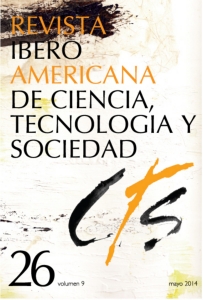The Internet generation
who they are and what they came here for. A case study
DOI:
https://doi.org/10.52712/issn.1850-0013-593Keywords:
Internet generation, social networks, social movements, digital democracyAbstract
This article aims at presenting a profile on the Internet generation, and at analysing how it uses the World Wide Web -as well as its tools- to engage in subjects related to civic, political and social aspects. The study was based on a literature review and its analysis was directed to the individuals of this generation since the beginning of their academic lives in public and private institutions.
Downloads
References
ADLER, R.; GOGGIN, J. (2005): “What do we mean by civic engagement?” Journal of Transformative Education, vol. 3, n° 3.
CASTELLS, M. (2003): A galáxia da Internet, Rio de Janeiro, Jorge Zahar.
CGI, Comitê Gestor da Internet no Brasil. Disponível em: http://www.cgi.br. Acesso em 30 de dezembro de 2011.
FELINTO, E. (2008): “Videotrash: o YouTube e a cultura do ‘spoof’ na internet”.
Revista Galáxia, São Paulo, nº 16, pp. 33-42.
KATZ, J. E.; RICE, R. E. e ASPEDEN P. (2001) “The Internet 1995-2000: access, civic involvement, and social interaction”, American Behavorial Scientist, vol. 45 (edição especial sobre a Internet e a vida cotidiana).
KIST, É. B. (2009): “Real x Virtual, Movimentos que Transcendem o Ciberespaço”. X Congresso de Ciências da Comunicação na Região Sul, Blumenau, 28 a 30 de Maio.
LÉVY, P. (2007): A inteligência coletiva: por uma antropologia do ciberespaço, São Paulo, Loyola.
MACHADO, J. A. (2007): “Ativismo em Rede e Conexões Identitárias, novas perspectivas para os movimentos sociais”, Sociologias, ano 09, nº 18, pp. 248-285.
MARCUSE, H. (1999): “Algumas implicações sociais da tecnologia moderna”, Tecnologia, guerra e fascismo, São Paulo, UNESP, pp. 71-104.
DE OLIVEIRA, R. G. e SANTOS, L. F. P. (2011): “Internet como alternativa para o engajamento cívico – Reflexões sobre o caso das ONGs”. IV Encontro da Associação Brasileira de Pesquisadores em Comunicação e Política, Universidade do Estado do Rio de Janeiro, 13 a 15 de Abril.
O’REILLY, T. (2005): “What Is Web 2.0: Design Patterns and Business Models for the Next Generation of Software”. Disponível em: http://oreillynet.com/pub/a/oreilly/tim/ news/2005/09/30/what-is-web-20.html. Acesso em 02 de janeiro de 2012.
SERRANO, D. P. (2011): “Geração X, Geração Y, Geração Z”, IFDBlog. Disponível em http://www.ifd.com.br/blog/marketing/geracao-x-geracao-y-geracao-z-%E2%80%A6/. Acesso em 17 de dezembro de 2011.
DA SILVA, S. P. (2005): “Graus de participação democrática no uso da Internet pelos governos das capitais brasileiras”. Revista Opinião Pública, Campinas, vol. 11, nº 2.
TAPSCOTT, D. (2010): A hora da Geração Digital, Editora Agir.
Downloads
Published
How to Cite
Issue
Section
License
Copyright (c) 2024 CC Attribution 4.0

This work is licensed under a Creative Commons Attribution 4.0 International License.
All CTS's issues and academic articles are under a CC-BY license.
Since 2007, CTS has provided open and free access to all its contents, including the complete archive of its quarterly edition and the different products presented in its electronic platform. This decision is based on the belief that offering free access to published materials helps to build a greater and better exchange of knowledge.
In turn, for the quarterly edition, CTS allows institutional and thematic repositories, as well as personal web pages, to self-archive articles in their post-print or editorial version, immediately after the publication of the final version of each issue and under the condition that a link to the original source will be incorporated into the self-archive.











